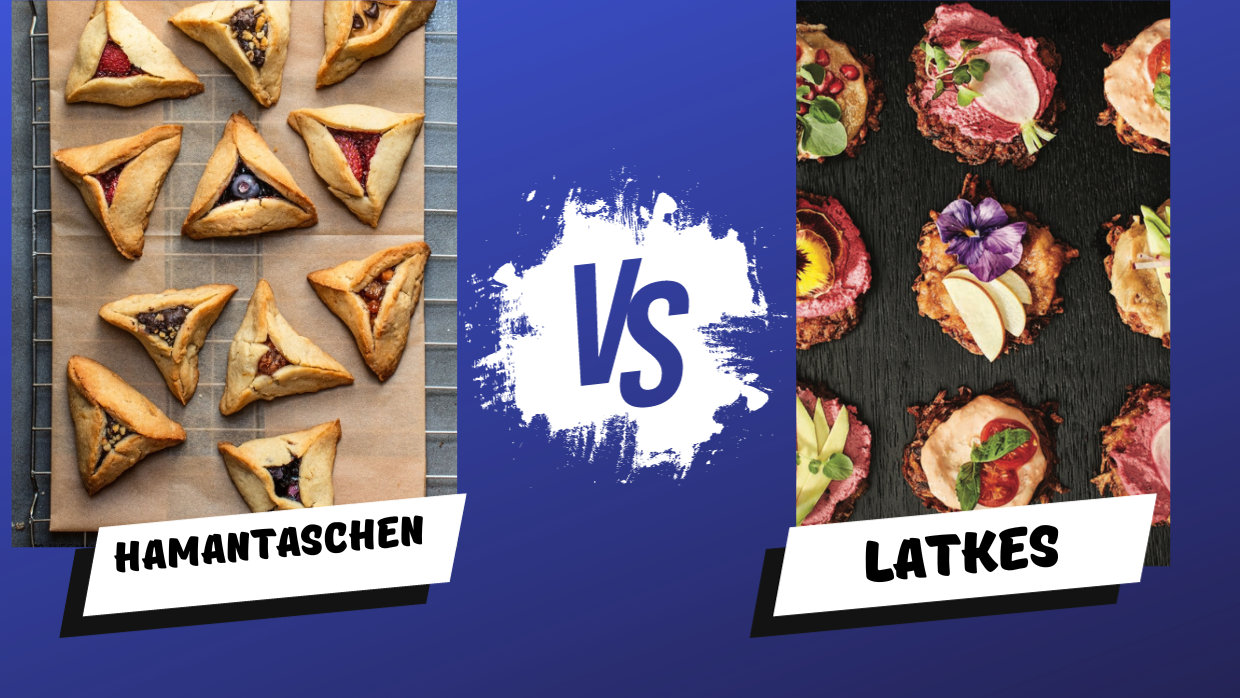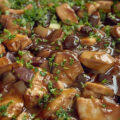If you're anything like me, the second the High Holidays are over, you're already counting the days till Hanukkah and Purim, when you can feast on tasty treats like crispy latkes and flaky hamantaschen guilt-free. These two Jewish culinary powerhouses are the highlights of the year, and I often wonder which Ashkenazi staple I look forward to more. I usually just feel lucky to have been born into a culinary tradition filled with so many delicious foods.
But that wasn't enough for the University of Chicago. They take their Jewish food very “seriously”. Since 1946, they have had an annual academic debate comparing Latkes and Hamantaschen to decide which one is the better Jewish delicacy.
The rules are simple, "all participants must hold a Ph.D. or equivalent degree; arguments should be framed according to the theoretical position and jargon of the participant's academic discipline; and each symposium must include someone who is not Jewish—to lend a note of 'gentility.'"
Best Arguments
Let's take a look at some of the best arguments that have been in the debate.
In the left corner, weighing in at a carbo-loaded 200 calories per serving, we have the latke!
And in the right corner, tipping the scales with crispy dough and sweet fruity or chocolatey filling, let's hear some noise for hamantaschen!
Will the potato pancake prevail, or will the triangular treat take the title? Place your bets for this traditional Jewish showdown. Let the great debate begin!
One great argument for the latke comes from American philosopher Ted Cohen, who demonstrated how sound philosophical reasoning would lead one to side with the latke by explaining, "Why must there be latkes? Because the latke is an absolutely and perfectly simple thing, as is revealed in the fact that the idea of a latke is a clear and distinct conception of the mind. When we have such an idea (which is rare) we know that the thing of which the idea is an idea, must exist. If there were no latkes, the idea of a latke would not be so simple…A world without hamantaschen would be a wretched world. A world without hamantaschen might be unbearable. But a world without latkes is unthinkable."
Professor Wendy Doniger proved, in a carefully footnoted paper entitled "The Archetypal Hamantaschen: A Feminist Mythology," that hamantaschen represent the womb and were worshiped in early matriarchal societies and therefore take precedence over the lowly latke, void of significance.
Another sound argument favoring the hamantaschen comes from historian Bernard Weisberger: "As anyone who has read Fredrick Jackson Turner knows, the seeds of American democratic institutions were planted on the frontier. And as any student of American history knows, the frontier was a place where the simplest and crudest instruments of life had to do double duty. In cookery, the uncomplicated frying pan was the pioneer's first resource; the axe, rifle, and skillet were the weapons in the conquest of the wilderness. And what kind of dish do we make in a frying pan?" Weisberger answers: "I assure you, it is not the high-priced confection. That demands an oven—a more complicated piece of engineering—to say nothing of such exotic, un-American, and civilized ingredients as prunes or poppy seeds."
Some of the esteemed Jewish thinkers and celebrities to show up and take part in these debates are none other than Steven Pinker, Harold Shapiro, and, Alan Dershowitz, who accused the latke of increasing the U.S.'s dependency on oil.
Astrophysicist Edward Kolb argues for a way to solve the debate once and for all: "Sadly, the quark structure of latkes and hamantashen has received precious little attention from scientists. This is due, no doubt, to the scandalous state of the National Science Foundation and the Department of Energy budgets. What I will unveil now is the outline for a sound scientific program to study the latke/hamatash quark structure. This program is courageous in scope, bold in vision, and, I am most proud to say, damned expensive ... This new machine, the Superconducting Super Hamalatkatron, or SSH for short, can be constructed at the modest cost of 8.264 billion dollars, a price which includes tax, tip, and dealer prep ... The food would be accelerated to high energy using the single strongest force known, the force of guilt."
Professors Jonathan Flombaum and Hollis Robbins supported the latke in the fifth debate at Johns Hopkins University in December 2010 on semiotic and philosophical grounds. They cited modern philosophers Spinoza and Jacques Derrida to highlight the latke's différance and to make the case that its "joyful heterogeneity" made it the superior holiday food.
In another debate, participants quoted the legal opinion of Justice Blackmun in the case of County of Allegheny v. ACLU, which claimed: "It is also a custom to serve potato pancakes or other fried foods on Hanukkah because the oil in which they are fried is, by tradition, a reminder of the miracle of Hanukkah." And by the time of writing this, the Supreme Court has given no such recognition to the Hamantaschen.
How It Began
The first-ever Latke v. Hamantash debate took place in 1946. The annual event's original purpose at the University of Chicago was as a way to explore Jewish traditions in a unique and humorous way. Ruth Fredman Cernea explains: "The event provided a rare opportunity for faculty to reveal their hidden Jewish souls and poke fun at the high seriousness of everyday academic life."
The debate also served a practical use. It typically takes place towards the end of the fall, right when examinations and term papers would be due, and it helped reduce some of the tension in the atmosphere amongst the students. She also argued that the debates reflected broad ethnic changes in the United States and helped Jewish students have a comfortable outlet to express their heritage and tradition.
After word about the first few debates got out in the intellectual community, more and more people wanted to get in on the action. And now there have been hundreds of debates country-wide.
Using humor to bring us closer together has always been a facet of Jewish life and culture. So this year, as we enjoy crispy latkes straight from the pan and toasty hamantaschen, it's time to ask yourselves, which Ashkenazic Jewish nosh are you siding with?






 Classic Latkes
Classic Latkes How To Make Hamantaschen
How To Make Hamantaschen











Latkes! Hands down. Why would you want to eat anything that has to do with Haman (BOO!!!) - his ear, his hat? No thanks. I’d much rather have nothing to do with the anti-Semite. Thank you very much! Shalom (and Chag Sameakh 🕎).
How about telling the world that "You've Got to be Tought to Hate" from the play South Pacific of 1949 (I believe). Playing this song around the world might do a little teaching.